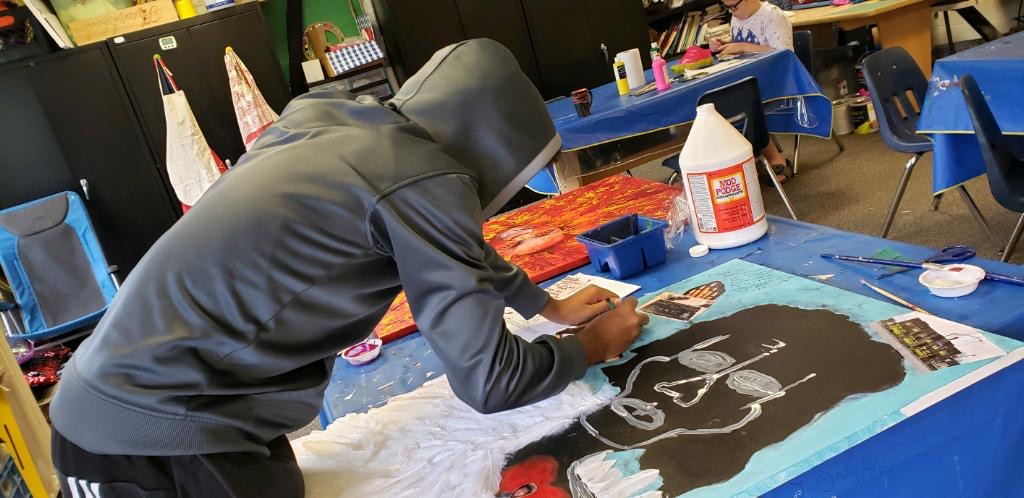Social Justice Art Projects: INjustice in Their Own Words
The narratives from Positive Education Program’s (PEP) social justice art projects will break your heart.
- I wanted to talk about my neighborhood. Well, even though it’s a bad neighborhood, it’s not as bad as people think when you live there. Everyone treats you like family. There is gang violence, shootings, and drug violence, and there is evil and hate. It’s scary. You gotta worry about dying, really.
- It’s serious being Black. We have a weight on my shoulders. It’s responsibilities. There are some kids who are young, real young, and they had to learn to take care of themselves. Say they don’t have dad and they have to provide for both…like what if my mama is sick…some kids get responsibilities they don’t even ask for…that is just part of life…you will always have weight on your shoulders.
- I would like someone to tell me once a day that they love me. I would like to have 10 hugs a day. I don’t hear that people love me in my family or at school. I need to hear that. I receive five hugs a day at school, but I need 10. I don’t get hugs at home and I don’t have anyone telling me they love me.
No child should have to worry about dying from gun violence. No child should carry the burden of looking after the adults in his life. Every child should be loved. But that’s not how it is.
Launching Social Justice Art Projects Initiative
This inequity, deeply felt by so many PEP students ꟷ all of whom have significant behavioral and mental health challenges ꟷ is the essence of social INjustice. And that’s why, Christa Boske, an associate professor who studies social justice and equity in schools, began volunteering with PEP students to explore the concept of social justice through art. Supported by PEP art teacher-counselors, Jeannie Oakar and Devon Fegen-Herdman, Boske worked with each student, introducing the concept of social justice, transcribing their narratives and guiding their artwork.
Boske believes working with the teens on these social justice art projects is a way to help them better understand their own worth and place of value in the world. She also believes it’s important for the kids to lead the project and have the autonomy to make choices about their art. “The more choice they have, the more power they have. Watching the process unfold, it’s clear that they haven’t had control or power in their own lived experiences. [Through this art] their confidence grows. They realize they matter.”
Understanding the Bigger Picture
This poem, which is a small part of one of the narratives, is the perfect example of a child grappling with the anguish of his past experiences and coming to understand them as the inadequacy of his environment and not as a failing on his part.
No one should be allowed to leave school.
Everyone should be able to learn.
It’s not right to put kids like me out.
I have anger issues.
I’m a good kid.
Don’t you see that?
Do you understand what I live?
I need teachers who care.
And look what happens when they do.
I learn.
I have all A’s.
I am smart.
I am calm.
I am happy doing this art.
These art projects provide an avenue for teens to explore difficult topics. Some talk about what it means to be a man and about the kind of father they hope to be one day. Others express a desire to leave a bad neighborhood but feel guilty about walking away from their community. As Oakar, one of the project’s innovators, explains, “It gives students time that’s individualized. They are not corrected and are able to just be themselves.”
Reframing Mindset through Art
The impact of this work is significant and is best expressed in the words of the kids’ themselves.
- It was hard to paint. The emotions were hard. I felt like I was definitely getting it out. I get it out often. This was a different way of getting it out. I felt really good after making this. I was proud of myself and I was relieved. It felt good to hear people say nice things about my art.
- It helped me talk about stuff so maybe it would help other kids too.
Boske says when she starts working with the teens they have a something-is-wrong-with-me mindset but they come away from it with the ability to be kinder to themselves. “Every kid I’ve worked with is used to society seeing them in a certain way and they all want people to come at them with a strength-based mind set.” Gratefully, that’s exactly what these projects have done.
For more information about PEP and its social justice art projects, contact us.
